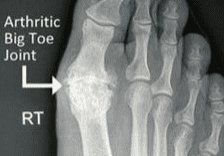Is there an association between occupation, footwear and osteoarthritis of the big toe joint?
Cherry, L. Gates, N. K. Arden & C. J. Bowen
The study aim was to determine whether lifetime occupation was associated with the presence of radiographic osteoarthritis (ROA) of the first metatarsophalangeal joint (MTPJ) in women.
The primary outcome was the presence of dorsal view ROA of the first MTPJ. The main exposure was lifetime occupation, categorised according to levels of occupation previously defined via international consensus: 1. Sedentary, 2. Light, 3. Light manual, 4. Heavy manual. Logistic regression analyses were conducted to quantify the relationship between lifetime occupation type and the presence of ROA of the first MTPJ, adjusting for age, body mass index and lifetime high-heeled footwear use as potential interactive variables for each decade.
Background:
OA is incredibly common. Hip and knee OA is ranked the 11th highest contributor to global disability. Previous research has shown a high prevalence of radiographic foot OA of between 17 and 33% of the population.
1st MPJ OA is associated with poorer health related QOL and reduced physical activity, reducing the amount of meaningful activity people are able to engage with. Currently, there is limited data on what potential risk factors are. A likely contribution of environmental, internal and genetic factors are hypothesized to play a role.
It is logical to believe that ‘excessive’ mechanical loading of the joint through bending and compressive force may contribute as this is seen in other joints such as knee OA in miners and carpenters. However, as we know the body is adaptable, it could be argued that although those joints are under significant load, it may be able to adapt.
Different to the knee and hip, footwear can play a role in the development of deformity, particularly, ill-fitting footwear. Shoes that are to narrow or tight may contribute alongside a job that is heavy in load.


Data were collected from the ongoing, prospective, population-based Chingford 1000 Women cohort study via questionnaires or/or clinical visits. This cohort of women, aged 45–64 years at inception, was originally established in 1989 from a single general practice in Chingford, UK, to explore determinants of osteoarthritis and osteoporosis progression. Data has subsequently been collected near annually creating an important epidemiological resource and one of the few such cohorts to include foot health data. Occupation and age data was used from baseline, x-ray, and BMI from year 6 and lifetime footwear from year 10.
Explanatory variables
The main exposure variable was predominant lifetime occupation recorded at baseline, which was captured with the following question and responses: “Previous occupation: Housewife; Retired; Higher Manager / professional; Skilled Manager / Teacher / Nurse; Admin / secretary / clerical; Skilled Manual; Unskilled manual; 9=cleaning / domestic?”. Occupation was categorised according to levels of activity previously defined via international consensus study, resulting in the assignment of each original group into one of four levels: 1. sedentary, 2. light, 3. light manual, 4. heavy manual [18] (see Table 1 for further detail).
Occupation categorisation
Other explanatory variables included age, body mass index and lifetime high-heeled footwear use. In line with radiographs BMI and age were also collected at year six. For footwear the question “Heel height worn at age xx” for each of the following decades of life was asked: under 20, 20–30, 30–40, 40–50, 50+. “Heel height worn at age xx?”. Footwear was dichotomised to low or high-heeled shoe use; a heeled shoe was defined as having a heel height of greater than two or more inches. This cut off was chosen based on that defined in the question proceeding these, which asked “‘Ever worn shoes with heels 2 inches high or more?”
What happened?
There were no statistically significant associations between lifetime occupation type and the presence of ROA of the first MTPJ in either the unadjusted, partially adjusted (for age and BMI) or fully adjusted models (for age, BMI, and lifetime high-heel footwear use for each decade of working life). This was true for all ages of high heel use from <20’s to 50+.
Discussion and takeaways:
This study found that occupation type (heavy or light) was not related to the presence or development of 1st MPJ OA as diagnosed by X-ray. This is interesting as with other joints like the knee and hip, we see some correlation. Limitations off the study only being with female and trying to recall footwear use and occupation.
Could this mean, as the study highlights, that 1st MPJ OA may be more likely to have contribution to its development from other factors such as social, BMI or inflammatory states. We are seeing this with knee OA with people having high C-reactive in their blood. Perhaps, this guides our public policy and advice to patients that keeping healthy and active is a way to reduce the risk of OA? Rather than recommendation supportive or offloading tools or blaming work. Education to patients is important about the potential causes and to explain that its likely not their work or footwear that has caused this, but factors that are somewhat in out control (BMI, health status) and out of our control (genetics, access to healthcare). As we can't change their anatomy, its pivotal to explain that the body still is adaptable and we are able to increase the capacity or raise the ceiling of what is tolerable through footwear, orthosis, taping and injections.
They did report:
When interrogating the data for the potential interactive/confounding effect of footwear, there was an increased frequency of first MTPJ OA observed in those wearing high heels in older decades versus younger decades. However, this could be due to age. They also had a smaller sample size.







